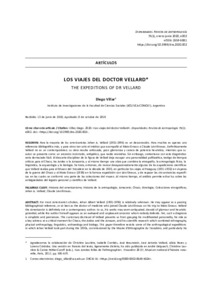Please use this identifier to cite or link to this item:
https://repositorio.uca.edu.ar/handle/123456789/10133| Título: | Los viajes del doctor Vellard The expeditions of dr Vellard |
Autor: | Villar, Diego | Palabras clave: | ETNOLOGIA; AMERICANISMO; ANTROPOLOGIA; VIAJES Y DESCRIPCIONES; GRUPOS ETNICOS; HISTORIA CULTURAL | Fecha de publicación: | 2020 | Editorial: | Consejo Superior de Investigaciones Científicas | Cita: | Villar, D. Los viajes del doctor Vellard [en línea]. Disparidades. 2020, 75 (1). doi:10.3989/dra.2020.002. Disponible en: https://repositorio.uca.edu.ar/handle/123456789/10133 | Resumen: | Resumen: Para la mayoría de los americanistas Jehan A. Vellard (1901-1996) es un desconocido. Para muchos es apenas una
referencia bibliográfica más, y para otros tan solo el médico que acompañó al Mato Grosso a Claude Lévi-Strauss. Definitivamente
Vellard no es un contemporáneo: su obra resulta anticuada, poco glamorosa y carece de potencia heurística, mientras que su
autor se presenta como un ancestro incómodo, antipático, que nadie reivindica. Sin embargo, contentarse con este diagnóstico
sería demasiado fácil. El descarte disciplinar de la figura de Vellard deja escapar una personalidad polifacética, testigo de tiempos
críticos para el Chaco, los Andes o la Amazonía, y al mismo tiempo una obra que combina la etnografía, la antropología física, la
lingüística, la arqueología y la biología. Se trata, entonces, de revisar desapasionadamente algunas de las expediciones científicas
que Vellard realiza para el Museo del Trocadero en la década de 1930, en particular los viajes al Paraguay (1931-1932) en vísperas
de la guerra del Chaco y al Mato Grosso (1938) en la famosa expedición con Lévi-Strauss, y de repasar las circunstancias específicas
en las cuales se conformó una parte de las colecciones del museo. Al mismo tiempo, el análisis permite echar luz sobre las
ambigüedades del legado personal y científico de Vellard. Abstract: For most Americanist scholars, Jehan Albert Vellard (1901-1996) is relatively unknown. He may appear as a passing bibliographical reference, or at best as the doctor of medicine who joined Claude Lévi-Strauss on his trip to Mato Grosso. Vellard the Americanist is definitely not a contemporary author: to us, his works may seem antiquated, devoid of glamour and heuristic potential, while the author himself appears as an awkward and unpleasant ancestor whom nobody defends. Yet, such a diagnosis is simplistic and premature. This customary dismissal of Vellard prevents us from grasping his multifaceted personality, his role as a key witness at a critical moment for Chaco, the Andes and the Amazon, and his scientific research which combined ethnography, physical anthropology, linguistics, archaeology and biology. This paper therefore revisits some of the anthropological expeditions in which Jehan Vellard took part during the 1930s, commissioned by the Musée d'Ethnographie du Trocadéro, and particularly his voyage to Paraguay (1931-1932) during the Chaco War and the famous Mato Grosso expedition (1938) with Lévi-Strauss. The aim is to reconstruct the specific context in which part of the Museum’s anthropological collections were formed, while at the same time shedding light on the ambiguities of the personal and scientific legacy of Jehan Vellard. |
URI: | https://repositorio.uca.edu.ar/handle/123456789/10133 | ISSN: | 2659-6881 (online) | Disciplina: | CIENCIAS SOCIALES | DOI: | 10.3989/dra.2020.002 | Derechos: | Acceso abierto | Fuente: | Disparidades. 2020, 75 (1) |
| Appears in Collections: | Artículos |
Files in This Item:
| File | Description | Size | Format | |
|---|---|---|---|---|
| viajes-doctor-vellard-villar.pdf | 336,04 kB | Adobe PDF |  View/Open |
Page view(s)
271
checked on Nov 28, 2025
Download(s)
238
checked on Nov 28, 2025
Google ScholarTM
Check
Altmetric
Altmetric
This item is licensed under a Creative Commons License

